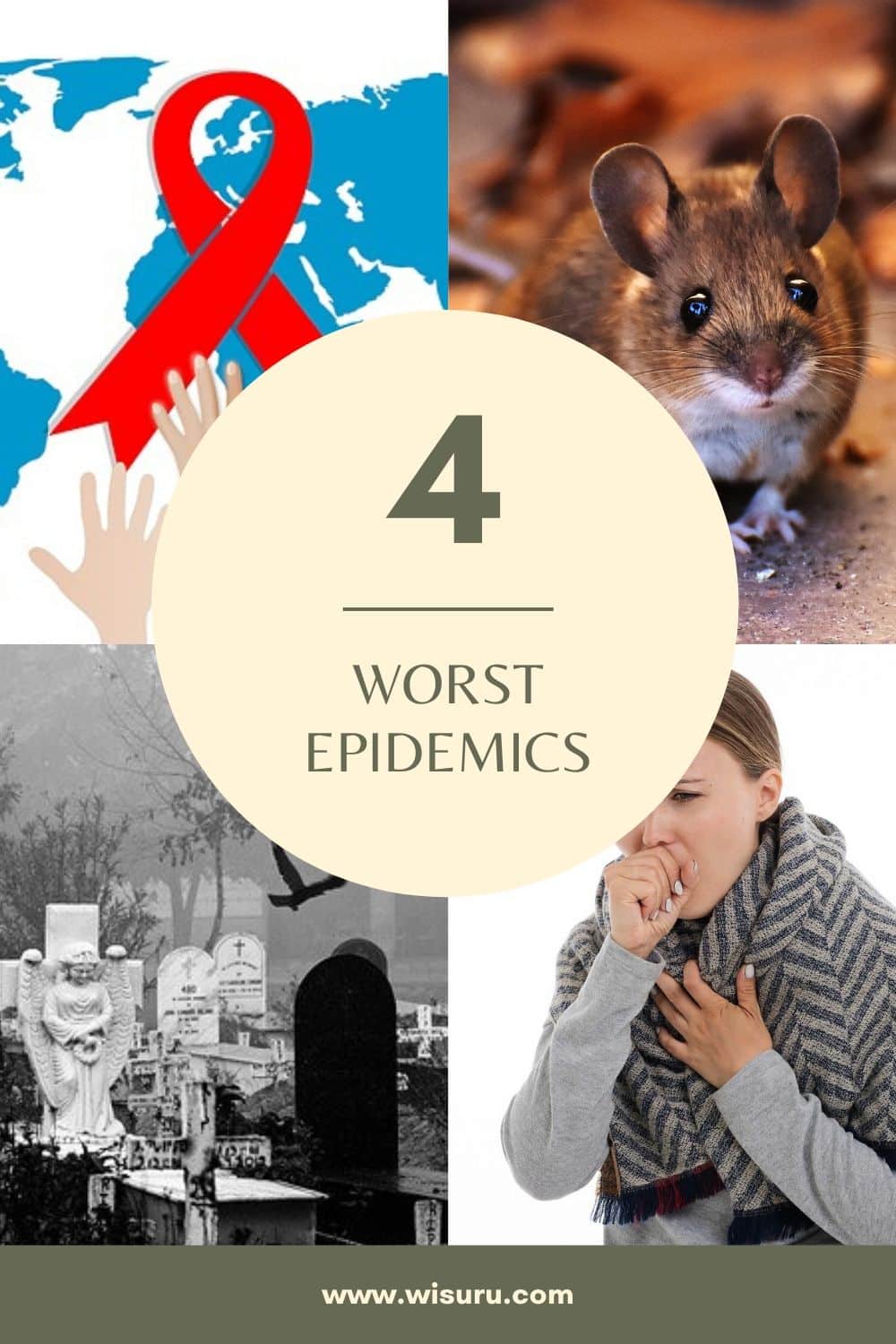
Even though wars and natural catastrophes had claimed millions of lives, both humans and animals, throughout the history of life on earth, some epidemics have completely wiped out human populations in some countries. This blog post looks at some of these worst epidemics in history.
Thanks to the improvement in medical field and hygiene, we can afford to live carefree without worrying about the occurrence of another such devastating epidemic in our neighborhood. But, it has not always been the case.
Endemic, Epidemic and Pandemic
An Endemic is a disease that exists in a specific region or population permanently. An Epidemic is an infectious disease that rapidly spreads across a huge community or population within a short period of time (within 2 weeks usually). A Pandemic is an epidemic that has spread throughout the world.
Several diseases appear harmless now due to the development of medical science. However, even the thought of these diseases horrified humans at a point in time. This article will discuss some of the worst epidemics in history based on the impact they had on the world’s population.
Worst epidemics in history
1. Plague of Justinian (541 AD – 542 AD)
Plague is a disease caused by Bacteria. It is found mainly in rodents (rats mainly) and the fleas which feed on these rodents. While some forms of Plague are transmitted to humans mainly through rodent or flea bites and are non-contagious, others are contagious spreading from humans to humans as well.
Which countries were affected?
One of the worst epidemics in history, the Plague of Justinian was named after Justinian The Great, the emperor of the Byzantine (East Rome) empire. The Byzantine Empire was the most affected empire because of the outbreak. It includes several present-day countries in Asia, Europe, and Africa (Greece, Turkey, Syria, Lebanon, Israel, Jordan, most Baltic states, and Egypt). The emperor himself contracted the disease but survived.
Where did it originate and how did it spread?
The Byzantine empire depended heavily on Egypt, for the supply of grains to feed its huge population. The disease might have been transmitted by the rats which were in the ships that carried these grains from Egypt. Modern investigations show that this Bacteria might have originated in China or India originally and might have been transmitted to Egypt because of trade, from where it spread to the Byzantine Empire.
How many people did it kill?
At its peak, the disease was killing 5,000 – 10,000 people a day. By 750 AD, when the disease vanished completely from Europe, it has already killed 50 to 100 million people. It erased 13% – 26% of the human population (at the time of its outbreak) from the face of the earth. During the time of Justinian, there wasn’t enough place to bury the dead, So, the corpses littered the streets, making the entire city smell like the dead.
Symptoms and death
According to historical records, people contracted with the disease showed symptoms like fever, headache, abdominal pain, etc. Some of these people then suffered from delusions, nightmares, and comas while others died almost immediately after showing these symptoms. These historical records, however, are not proven to be accurate.
How did the Plague of Justinian vanish?
Nobody knows exactly why, but the bacteria that caused the Plague of Justinian evolved itself into extinction. It probably evolved into a species that couldn’t survive and died out or into a species that wasn’t lethal.
What would happen if it occurred now?
The Plague of Justinian cannot reoccur today, because its traces have completely vanished.
2. Black Death (1347 AD – 1351 AD)
Also known as the Black Plague or the Great Plague, this epidemic reoccurred several times in history. This is widely considered the worst epidemic in history. The last occurrence of this plague was in the 19th century. It is a type of Bubonic Plague that spreads from rodents to humans but not from humans to humans.
Which countries were affected?
Many countries in Asia and Europe were severely affected. Europe lost somewhere between 30% – 60% of its population to the plague. In the 14th century, the plague reduced the population of the world from 475 million to 350 – 375 million. It took 200 years for the world to recover its lost population.
Where did it originate and how did it spread?
The disease is believed to have originated in Asia (mostly China). Due to the climate change in Asia, the grasslands died out. So, the rodents fled to more fertile lands spreading the disease. The traders traveling through the Silk route brought the disease to Russia, from where it traveled by trade ships to Europe. Armies with infected soldiers attacking other countries spread the disease. Famines and lack of hygiene catapulted the disease into an epidemic.
How many people did it kill?
In the three times the Dark Plague hit (Outbreak -14th century, Second plague pandemic -14th to 17th century, Third plague pandemic -19th century), somewhere between 75 to 200 million people died.
Symptoms and death
The most common symptoms were the occurrence of tumors (as big as an apple) in armpits and groins. This was then followed by fever and vomiting of blood. 80% of these victims died within the next 2 to 7 days.
How did the Black death vanish?
The Black Death was exterminated not by humans or medical science, but by 2 rules of nature.
1. Nature of the plague – Black Death is a deadly epidemic that killed 80% of its victims. A pathogen (harmful microorganism) that kills its victims cannot survive for long, because it eventually runs out of victims thereby causing its own extinction.
2. Evolution – Since Black Death existed long enough, some of the humans started developing resistance to it, due to mutation (change in DNA). The disease had a higher success rate of killing people without the mutation than people with this mutation. This led to future generations of humans who had more resistance to the disease.
What would happen if it occurred now?
Unlike its cousin ‘Plague of Justinian’, the ‘Black Death’ still survives, killing someone or the other somewhere. However, it is not as deadly as before because we have antibiotics now and antibiotics are very effective against the plague. In addition to that, huge cities, where the epidemic is likely to emerge, have controlled rat populations, and improved hygiene.
3. AIDS (1959 AD – present)
The Acquired Immune Deficiency Syndrome (AIDS) caused by the Human Immunodeficiency Virus (HIV) is one of the worst epidemics in history, that humanity has ever seen.
Which countries are affected?
Africa is the continent worst affected by AIDS. Almost two-thirds of all the people infected by HIV live in Africa. In two of those countries, more than one-fourth of the population is infected by HIV. The main reasons for AIDS being prevalent in these parts of the world are sex-based violence, lack of proper information about the disease, and lack of proper medical care.
Where did it originate and how did it spread?
The source of HIV is a species of Chimpanzee prevalent in West Africa. Several decades ago, when hunters hunted these Chimpanzees for food, they might have contracted the Chimpanzee version of HIV. This virus could have later undergone mutation to become HIV that affects humans. This later spread to other parts of Africa. The earliest occurrence of AIDS was in Congo in 1959.
How many people did it kill?
Approximately 39 million people have died because of HIV and an additional 36.9 million people are still living with HIV.
HIV might not have killed as many people as the Plague of Justinian or the Black Plague. But it has killed so many people in the modern era when there are no large-scale wars and when the medical field is so advanced. (In my opinion) Had it occurred several centuries ago when large scale wars, unprotected sex, and other epidemics were so prevalent, it could have killed several times as many people.
Symptoms and death
HIV weakens your immune system to a point where it cannot fight against common germs. This makes the victim more prone to other types of infections (specifically cancers and tumors) and diseases that can be deadlier than normal. But HIV can survive 10 years in the victim’s body without showing any symptoms. During this time, it kills the proteins in the body while making a copy of itself.
HIV can be transmitted through sex, blood, childbirth or through breastfeeding.
How has the medical field helped the victims?
While the medical field couldn’t find a cure for AIDS till now, it has definitely helped increase the life longevity of the victims. When identified at an early stage, the medications can help a 20-year AIDS victim live another 46 years. This is an impressive medical feat.
The problem, however, is that most people don’t realize they have HIV until the last stage. In addition to that, even though these medications certainly help the people in the West, the majority of people in Africa don’t have the financial means to avail these medications.
Prevention
Using condoms, using disposable syringes and increasing the awareness about the disease can help prevent AIDS.
4. Spanish flu (1918 AD – 1920 AD)
Also known as the 1918 Influenza pandemic, the Spanish flu is one of the worst epidemics in history to have attacked mankind. The Spanish flu virus is notorious (when compared to other influenza viruses) for its ability to reproduce itself (up to 39,000 more) and its lethality (up to 100 times more).
Which countries were affected?
The Spanish flu was a pandemic. A pandemic is an epidemic that has spread throughout the world. So, different countries around the world were affected. Due to the first world war, occurrences of the 1918 Influenza pandemic in the fighting nations like the USA, Germany, UK were not reported (accurately) so as to not affect the morale of the soldiers. However, in Spain, a neutral nation, the incidents (including the king contracting the disease) were reported. Therefore, the 1918 Influenza pandemic also came to be known as the Spanish flu.
Where did it originate and how did it spread?
The Spanish flu might have originated in France or in USA. A cough or sneeze of an infected person can release hundreds of thousands of these viruses which spread the flu to those nearby. Wartime mobilization of troops meant that the disease can spread faster and travel farther.
How many people did it kill?
About one-third of the world’s population was infected by the Spanish flu and 10% -20% (50 – 100 million people) died because of it. 99% of the people who died were less than 65 years old. Normally, Influenza kills the very young and the very old. However, the Spanish flu also killed very healthy adults (aged 20 – 40). This was both a unique and scary feature of this influenza.
Why did so many young adults die?
This was probably due to the Russian flu (caused by Group 2 Influenza virus) that killed around 1 million people during 1889 – 1890. Normally, people who contract the flu at one point in their life become resilient to the same or similar type of flu virus. So, kids born during this time had increased resilience to Group 2 virus. However, this could have caused these kids to become more susceptible to Spanish Flu which was caused due to a Group 1 Influenza virus.
Symptoms and death
Symptoms included fever, body pain, and diarrhea. Patients would then suffer from lack of oxygen as a bloody, frothy substance filled the lungs leading to death.
How did the Spanish flu vanish?
The Spanish flu could have evolved itself into a less lethal one, because it runs out of victims, if it kills all its victims. The doctors might have also gotten better at treating the disease.
What would happen if it occurred now?
In 1918, the Spanish flu was so effective not just because of the nature of the virus, but also because of the time when it occurred. It occurred at the time of the first world war. Mobilizing troops meant groups of people crowded in closed areas, which helped influenza spread faster.
In addition to that, healthcare services were limited and the medical technology was not as advanced as today. Isolation of victims and supportive care were the only options available at that time. Hence one of the worst epidemics in history killed so many people.
Today, the world is better prepared for such epidemics because of advancements in the fields of disease surveillance, medical technology, vaccines, and pandemic planning. Besides, WHO has a dedicated organization that monitors changes in flu viruses and also looks for new flu viruses.
Should a new influenza pandemic attack us, we would have a vaccine against it in 20 weeks. However, due to the current human population, we would fall short on the number of vaccines we can mass-produce and their cost would mean that several poor countries would not be able to afford them.
We hope that this blog post on the worst epidemics in history helped you understand about epidemics and the damage they caused to the human society.


Leave a Reply